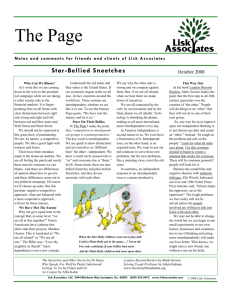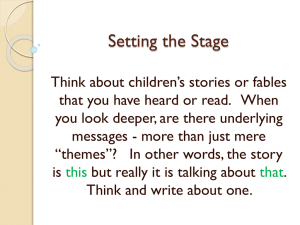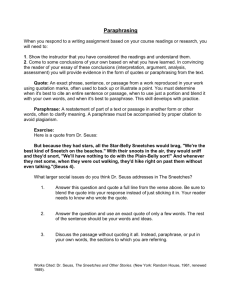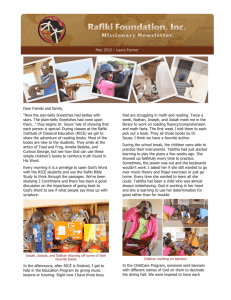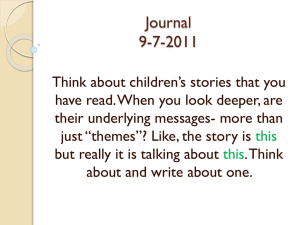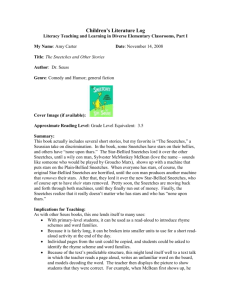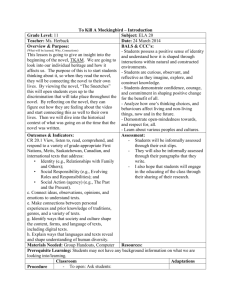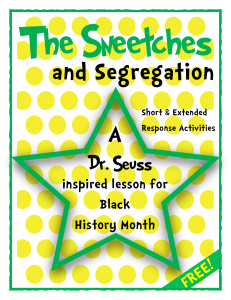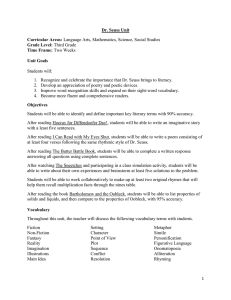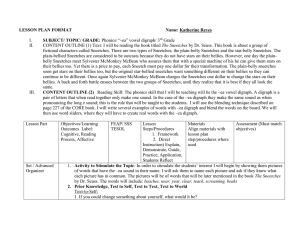first grade - CONNECTIONSNC
advertisement
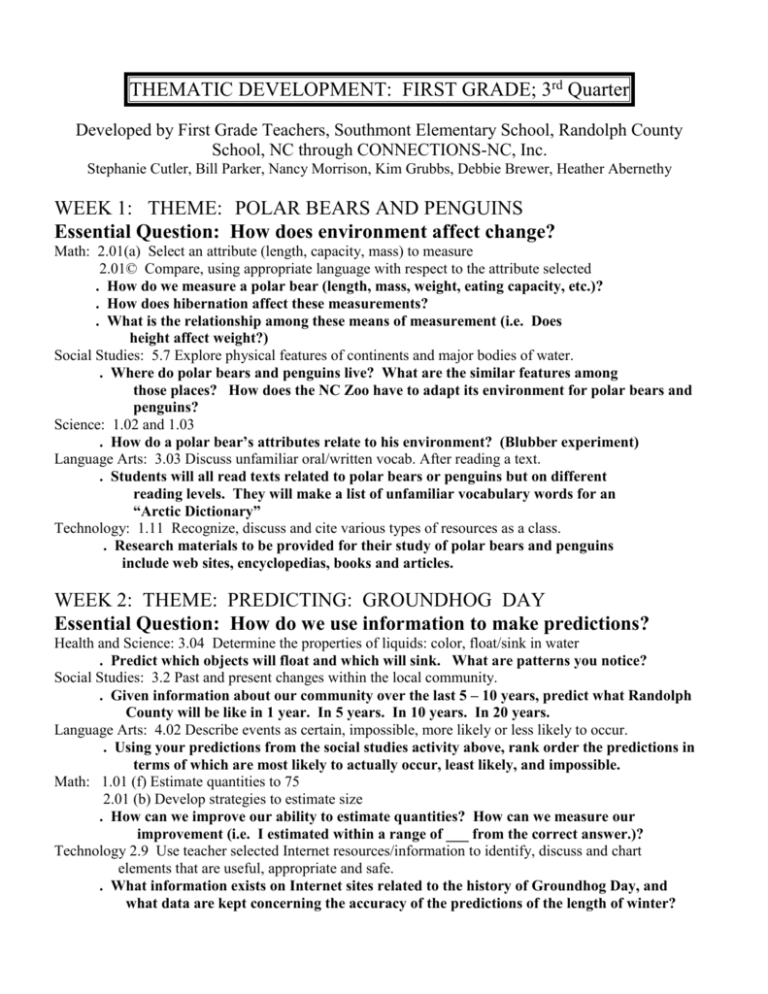
THEMATIC DEVELOPMENT: FIRST GRADE; 3rd Quarter Developed by First Grade Teachers, Southmont Elementary School, Randolph County School, NC through CONNECTIONS-NC, Inc. Stephanie Cutler, Bill Parker, Nancy Morrison, Kim Grubbs, Debbie Brewer, Heather Abernethy WEEK 1: THEME: POLAR BEARS AND PENGUINS Essential Question: How does environment affect change? Math: 2.01(a) Select an attribute (length, capacity, mass) to measure 2.01© Compare, using appropriate language with respect to the attribute selected . How do we measure a polar bear (length, mass, weight, eating capacity, etc.)? . How does hibernation affect these measurements? . What is the relationship among these means of measurement (i.e. Does height affect weight?) Social Studies: 5.7 Explore physical features of continents and major bodies of water. . Where do polar bears and penguins live? What are the similar features among those places? How does the NC Zoo have to adapt its environment for polar bears and penguins? Science: 1.02 and 1.03 . How do a polar bear’s attributes relate to his environment? (Blubber experiment) Language Arts: 3.03 Discuss unfamiliar oral/written vocab. After reading a text. . Students will all read texts related to polar bears or penguins but on different reading levels. They will make a list of unfamiliar vocabulary words for an “Arctic Dictionary” Technology: 1.11 Recognize, discuss and cite various types of resources as a class. . Research materials to be provided for their study of polar bears and penguins include web sites, encyclopedias, books and articles. WEEK 2: THEME: PREDICTING: GROUNDHOG DAY Essential Question: How do we use information to make predictions? Health and Science: 3.04 Determine the properties of liquids: color, float/sink in water . Predict which objects will float and which will sink. What are patterns you notice? Social Studies: 3.2 Past and present changes within the local community. . Given information about our community over the last 5 – 10 years, predict what Randolph County will be like in 1 year. In 5 years. In 10 years. In 20 years. Language Arts: 4.02 Describe events as certain, impossible, more likely or less likely to occur. . Using your predictions from the social studies activity above, rank order the predictions in terms of which are most likely to actually occur, least likely, and impossible. Math: 1.01 (f) Estimate quantities to 75 2.01 (b) Develop strategies to estimate size . How can we improve our ability to estimate quantities? How can we measure our improvement (i.e. I estimated within a range of ___ from the correct answer.)? Technology 2.9 Use teacher selected Internet resources/information to identify, discuss and chart elements that are useful, appropriate and safe. . What information exists on Internet sites related to the history of Groundhog Day, and what data are kept concerning the accuracy of the predictions of the length of winter? WEEK 3: DIVERSITY: BLACK HISTORY MONTH Essential Question: In what ways are we alike and different? What have been the major contributions of African Americans? Health and Science: 1.01 Investigate the needs of different plants: air, water, light, space . What were George Washington Carver’s contributions to the study of plants? Do some of his experiments to better understand the needs and uses of different plants. Social Studies: 4.2 Observing special days celebrate/individuals of different cultures . What other famous African Americans have contributed to making this a better world? Language Arts: 3.06 Discuss author’s /speaker’s use of different kinds of sentences to interest a reader/listener and communicate a message. . Listen to a recording or reading of “I Have A Dream.” What gave Martin Luther King’s speech power? How did he use different sentences? How did he interest the listener? Write a speech that makes people want to do something. Math: 1.01 (g) Equivalent sets and numbers to 75 1.02 Use groupings of 2’s with models and pictures to count collections of objects . How can equivalent sets be the same and yet different? How is that like our differences? . Sort seeds from the science experiments into sets of 2’s to be planted in pairs. Technology: 2.8 Explore internet resources and information using teacher-created bookmarks/favorites and discuss types of information found. . Use web sites to find biographical information on different African Americans and their contributions. WEEK 4: PATTERNS: DR. SEUSS’S BIRTHDAY ESSENTIAL QUESTION: What patterns exist within Dr. Seuss’s writings and what impact did he have? Health and Science: 3.05 Observe mixtures: Solids and Solids; liquids and liquids; solids and liquids . Experiment with the states of matter through the use of ooblick. Technology: 1.13 Identify and discuss ownership of creative work online . Discuss who should “own” Dr. Seuss’s work, and who owns creative work on the internet. Discuss plagiarism. Language Arts: 3.06 continued . What patterns did Dr. Seuss use to interest his readers? ? How did he use different sentences? Compare Dr. Seuss’s writings to Dr. King’s speech in terms of patterns (repetition, etc.). Math: 1.02 Use groupings of 2’s with models and pictures to count collections of objects. . Find pairs of rhyming words and pairs of objects within the illustrations of Dr. Seuss’s books. (ex. Thing 1 and Thing 2) Social Studies: 4.2 Observing special days celebrate/individuals of different cultures . Celebrate Dr. Seuss’s Birthday. Have students categorize celebrations into which are celebrated around the world and which are only for certain cultures or countries. Social Studies: 5.5 Demonstrate responsibility for the care and management of the environment with the school and community . Read The Lorax and discuss individuals’ responsibilities to the environment. WEEK 5: STATES OF MATTER ESSENTIAL QUESTION: How do changes affect the states of matter? Health and Science: 3.01 – Matter- Describe the differences in the properties of solids and liquids. . Based on the last week’s experiments with ooblick, be able to describe the many changes that occur when solids are converted to liquids, and liquids to solids in terms of properties. Weigh shrimp (or fruits) frozen and thawed to see how freezing affects weight. Experiment with which freezes fastest to slowest: colas, hot water, cold water, fruit juices, salt water, etc. 3.02 Identify, build and name cylinders, cones and rectangular prisms. . Freeze water in different prism-shaped containers, and compare how much water it takes to fill the different shaped containers. Social Studies: 3.4 Members of the community are affected by changes in the community. . Read The Sneetches on the Beaches and discuss differences in individuals, communities and cultures. Compare the differences between the Star-bellied Sneetches and the Plain-bellied Sneetches with the differences among states of matter of the same substance (water). How does that make them alike? How does that make them different? Language Arts: 2.08 How, why, what if? . In relation to the reading above (The Sneetches), ask questions such as the following: . How did the plain-bellied Sneetches feel in the beginning? How did that change? Why? Were they really different with stars, or did they just perceive that they were different? . What changes did the original star-bellied Sneetches experience? Why? . How were the plain-bellied and star-bellied Sneetches always alike? Different? . What would have happened if McMonkey McBean had never come along? . What would have happened if McMoney McBean had refused to take off the original Star-bellied Sneetches’ stars? . Did McMonkey McBean have a right to make so much money off of the Sneetches? Math: 1.01 (a) represent numbers in a variety of ways – 51 – 75 (number words 11 – 19) (b) Use strategies to count number of objects in a set (51 – 75) . Have students count and group objects that are cylinders, cones and rectangular prisms. Have them match number words to groups of objects. Discuss how different ways of expressing a number is similar to different states of matter of the same substance. WEEK 6: POWER OF WIND ESSENTIAL QUESTION: How does the power of the wind create change? Health and Sciences: 3.02 Investigate several ways in which objects can be sorted, described or classified 4.01Describe different ways in which objects can be moved. 4.02 Observe that movement of an object can be affected by pushing or pulling 4.03Investigate and observe that objects can move steadily or change direction Big Book F: Push/Pull . Have students create sailboats of different designs, and race them across a tub of water by blowing or using a fan to simulate the wind. Discuss observations concerning why certain designs move more easily. Do the same with kites. Social Studies: 5.3 Create maps of earth’s physical and human features using geographic terminology. . Have students create Taba “Effects of the Effects” chart, starting with the power of wind, to examine how wind affects the earth. Example: plants grow where they aren’t planted The wind blows seeds. Too many plants grow in one area WIND Water moves. Waves help boats move. Can create hurricanes. . While looking at a map or globe, allow students to hypothesize how the wind has effected the earth’s features, and how the earth’s features (like mountains or oceans or rivers) might affect the wind’s power. Language Arts: . Math: . 4.03 Use specific words to name and tell action in oral and written language. Have students brainstorm a word bank for completing these sentences: - The boat _____________ across the tub. - The kite ______________ through the sky. - When the wind ___________, I can hear it. 1.01(e) Build an understanding of place value (ones and ten) Discuss how much more power 10’s have than 1’s. Talk about parallels between tens and ones and the power of the wind, such as ones being little summer breezes and 10’s being strong fall winds. Have the students act out the power of a “one’s wind” and a “tens wind.” WEEK 7: POWER OF MAGNETS ESSENTIAL QUESTION: How does magnetic power create change? Health and Sciences: 4.01Describe different ways in which objects can be moved. 4.02 Observe that movement of an object can be affected by pushing or pulling 4.03Investigate and observe that objects can move steadily or change direction Big Book F: Push/Pull . Continued; . Experiment with different sizes of magnets and different substances. Categorize things that are and are not magnetic. . Compare the power of the wind to the power of magnets. How are they alike in lots of ways? How are they different in lots of ways? Social Studies: 3.4 Members of the community are affected by changes in the community. . Discuss the magnetic forces that “attract and repel” within your community. Language Arts: . Math: 4.03 Use specific words to name and tell action in oral and written language. Have students brainstorm a word bank for completing this sentence: The magnet _____________ the paper clips. . Discuss the power of words. Make a list of action words and put them in order in terms of their power. (i.e. crawled, walked, ran, flew) . Make a list of “Magnetic words” that attract, and that repel. (Ex. – attract: cute, pretty, colorful; repel: stinky, ugly, mean) 1.01 © Read and write numbers 51 – 75 1.01 (d) Compare and order sets of numbers 51 - 75 . Have students group paper clips from the magnet experiments in multiple ways. Be sure that there are between 50 and 75 paper clips. Have them group the 10’s and left over 1’s and write the quantity. For students ready to go beyond, group the paper clips in multiple ways and look for patters – groups of 2’s, 3’s, 4’s, 5’s, etc. WEEKS 8 and 9: CHANGE ESSENTIAL QUESTIONS: How is change created? What are the effects of change? How do changes to one thing affect changes in another thing? How has our community changed over time? Health and Science: 3.02 Investigate several ways in which objects can be sorted, described or classified Social Studies: Language Arts: Math: 3.3 Changes within the local community and communities around the world. Community Helpers. 3.01 How information and events relate to life. . Brainstorm events that have created change within our community, our country, and our world. Put them in priority order in terms of which YOU think created the biggest changes. Why? 2.02 Solve problems involving applications of time (hour and half hour) . Brainstorm what kinds of changes can happen within an hour. Within a half hour. What kinds of changes need to take place over a day? A month? A year? Categorize changes in terms of the time they take.
